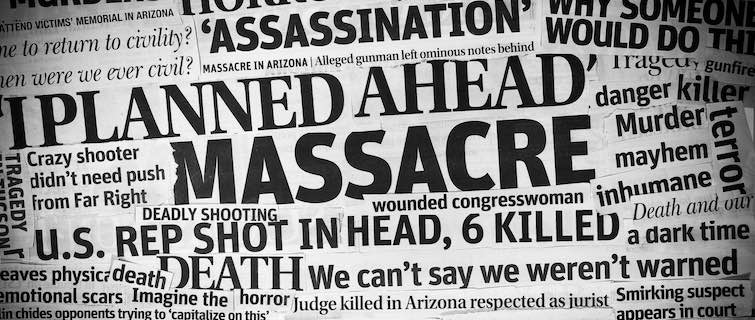
At odd times, her mind still conjures vivid images of the shootings. She’s more irritable now, has trouble sleeping, even wakes sometimes from night terrors. The attack that killed 20 people in her hometown of El Paso, Texas, last August left Erin Coulehan with an emotional scar that is common among people who have experienced trauma.
But Coulehan didn’t witness the massacre firsthand. When she heard about the attack, she was thousands of miles away, at New York City’s LaGuardia Airport, preparing to board a flight home to Texas.
She covered the story for The New York Times.
Coulehan’s experience is not unusual. Like police officers, firefighters, EMTs, and other professionals called to natural and human-made disasters, journalists are at increased risk of developing conditions such as depression and post-traumatic stress disorder (PTSD).
“Like therapists—who through the process of ‘transference’ can vicariously experience their patients’ emotional pain—reporters may also experience a type of indirect, secondary trauma through the victims they interview and the graphic scenes to which they must bear witness,” wrote Natalee Seely, an assistant professor of journalism at Ball State University, in a 2019 study published in the Newspaper Research Journal.
An Occupational Hazard
For many journalists, witnessing traumatic events is an occupational hazard—it comes with the territory. But the extent of that risk varies greatly with the duration and intensity of the exposure, with studies showing PTSD rates ranging from up to 11 percent for U.S. print reporters to as high as 59 percent for Mexican photographers, many of whom cover the drug trade.
But journalists can reduce the severity of this trauma through prior training, careful preparation for emotionally taxing assignments, and an intentional response to trauma itself.
Coulehan, a stringer for The Times who has also written for Elle, Rolling Stone, and other publications, sought help at a temporary trauma center in El Paso, set up after the shootings. Diagnosed with PTSD, she went to the center three times and learned coping mechanisms that have helped with her sleep problems and anxiety.
“Just because you can report on everything and do 10 interviews a day doesn’t mean that you should,” said Coulehan, citing some of the advice she received. “I can’t do my job if I’m not taking care of myself—I can understand that.”
A Different Attitude
That attitude might seem reasonable now, but it was largely unexpressed when Carole Feldman began reporting for a small New Jersey daily in the 1970s. She recalled the first time she saw a dead body—a shooting victim lying on the street—while covering the police beat, but that there was neither a place nor a person she could go to in order to discuss her reaction.
Society has changed since then, and so has the journalism profession.
“It’s important for reporters, editors, and news directors to talk about the situation they’re going into—before they go in, while they’re there, and in the aftermath,” said Feldman, interim faculty director for the Master’s in Journalism program at Georgetown University.
Coulehan, a 2014 graduate of Georgetown’s program, recalls skills learned in her ethics and non-fiction narratives classes, where students discussed journalists’ responsibilities and the need for both objectivity and empathy when covering traumatic events.
“As a journalist, you’re there to cover the story, not to become part of it,” Feldman said, adding, however, that sometimes participation is inevitable. “Part of this is balancing your role as a journalist with being a human being.”
When a Disaster Hits Home
As an El Paso native, Coulehan was ideally suited to add depth, context, and empathy to The Times’ covering of the shootings—despite the consequences. She first heard about the August 3 shooting from a friend, who texted her about it when Coulehan was at LaGuardia.
“I thought it was, like, a drunken fight that morning at Hooters,” she said.
Then she got another text—this time from her editor at The Times, where she had worked as a stringer on a story about life in the border patrol. Almost immediately she thought about her father, who made regular Saturday shopping runs to the shopping center where the shooter—emboldened by anti-immigrant screeds he had heard on the internet—had killed 24 people and wounded another 24.
She called her father and was relieved to hear he was okay: He had decided to go shopping earlier that day. She wrote a story for Esquire about that call and about her own happy memories of her mother driving her and her sister to the shopping center to buy school supplies for the coming year. It was what many residents were doing on the day the gunman attacked.
In the four days after the shootings, Coulehan and three other Times staffers conducted about 50 interviews. She wasn’t present in the immediate aftermath of the shootings, so she hadn’t seen the carnage up close; but she had seen photos, and that was disturbing enough.
Gradually, however, with time and talk therapy, her spunk and sense of humor returned.
“I have appointments at the PTSD clinic and my hair stylist this afternoon,” she tweeted one day in late August. “Very big day for my head.”
Looking back, she’s glad she was sent to cover the shootings, despite the personal cost.
Readers and fellow journalists needed that local perspective, she said. “I had the very special opportunity, [with] both my background and education, to help provide accurate news coverage while also ensuring the cultural integrity of the city was represented.”